KCET 2023 Biology Question Paper Set D2 is available here for download. KCET 2023 Question Paper May 20 Shift 1 10:30 AM to 11:50 AM has been conducted for Biology Paper. KCET 2023 Question Paper consisted of 60 MCQ-based questions in total. Each candidate is awarded +1 for correct answers, however, there will be no negative marking for incorrect responses. Students got 80 minutes to attempt KCET 2023 Biology Question Paper.
KCET 2023 Biology Question Paper with Answer Key PDF Set D2
![]()
Question 1:
Identify the correct option showing the relative contribution of different greenhouse gases to the total global warming.
- (A) CFC-20%, CO\(_2\)-60%, Methane-14%, N\(_2\)O-6%
- (B) CFC-6%, CO\(_2\)-60%, Methane-20%, N\(_2\)-14%
- (C) CFC-14%, CO\(_2\)-60%, Methane-6%, N\(_2\)-20%
- (D) CFC-14%, CO\(_2\)-60%, Methane-20%, N\(_2\)O-6%
Question 2:
A flower has 10 stamens each having bilobed dithecous anther. If each microsporangium has 5 pollen mother cells, how many pollen grains would be produced by the flower?
- (A) 400
- (B) 800
- (C) 1600
- (D) 200
Question 3:
During transcription, the DNA strand with 3' → 5' polarity of the structural gene always acts as a template because:
- (A) Enzyme DNA dependent RNA polymerase always catalyse the polymerisation in 3' → 5' direction.
- (B) Enzyme DNA dependent RNA polymerase always catalyse polymerisation in both the directions.
- (C) Nucleotides of DNA strand with 5' → 3' are transferred to mRNA.
- (D) Enzyme DNA dependent RNA polymerase always catalyse the polymerisation in 5' → 3' direction.
Question 4:
According to David Tilman’s long term ecosystem experiments, the total biomass in plots with more species shows:
- (A) High variation from year-to-year.
- (B) Average variation from year-to-year.
- (C) No variation from year-to-year.
- (D) Less variation from year-to-year.
Question 5:
The toxic heavy metals from various industries which cause water pollution, normally have a density
- (A) more than 15 g/cm\(^3\)
- (B) more than 7.5 g/cm\(^3\)
- (C) more than 12.5 g/cm\(^3\)
- (D) more than 5 g/cm\(^3\)
Question 6:
Find out the correct match.
Diseases, Pathogens, and the Main Organs Affected:
- (A) Typhoid, Bacteria, Lungs
- (B) Filariasis, Common round worm, Small intestine
- (C) Dysentery, Protozoa, Liver
- (D) Ringworm, Fungus, Skin
Question 7:
Match the following columns and choose the correct option:
![]()
- (A) r s p q
- (B) s p q r
- (C) r p q s
- (D) q r s p
Question 8:
From the following tools/techniques of genetic engineering, identify those which are required for cloning a bacterial gene in animal cells and choose the correct option:
I. Endonuclease
II. Ligase
III. A. tumefaciens
IV. Microinjection
V. Gene gun
VI. Lysozyme
VII. Cellulase
VIII. Electrophoresis
Options:
- (A) I, II, IV, VI, VIII
- (B) I, III, IV, V, VII
- (C) II, III, IV, VI, V, VII, VIII
- (D) II, III, V, VII, VIII
Question 9:
Identify the incorrect statement regarding the flow of energy between various components of the food chain.
- (A) Energy flow is unidirectional.
- (B) Green plants capture about 10% of the solar energy that falls on leaves.
- (C) Each trophic level loses some energy as heat to the environment.
- (D) The amount of energy available at each trophic level is 10% of the previous trophic level.
Question 10:
Flame cells present in the members of platyhelminthes are specialized to perform:
- (A) Osmoregulation and Excretion
- (B) Respiration and Excretion
- (C) Respiration and Osmoregulation
- (D) Osmoregulation and Circulation
Question 11:
Identify the floral formula of plant belonging to the potato family.
- (A) \( \oplus, K(5), C_5, A_{9}+1, G_1 \)
- (B) \( \oplus, K(5), C_5, A_5, G_2 \)
- (C) \( \oplus, K_{10}, C_{10}, A_{10}, G_2 \)
- (D) \( \oplus, P_{3+3}, A_{3+3}, G_3 \)
Question 12:
When the vascular cambium is present between the xylem and phloem, then the vascular bundle is called:
- (A) Open
- (B) Endarch
- (C) Closed
- (D) Exarch
Question 13:
The function of Typhlosole in earthworm is:
- (A) Grinding of decaying leaves
- (B) Transportation
- (C) Increasing the effective area of absorption in the intestine
- (D) Grinding of soil particles
Question 14:
Select the correctly matched pair of organisms with their order:
- (A) Musa, domestica : Diptera
- (B) Homo, sapiens : Poales
- (C) Mangifera, indica : Primata
- (D) Triticum, aestivum : Sapindales
Question 15:
Match the column-I with column-II and choose the correct option from the following:
![]()
- (A) r p s q
- (B) q p s r
- (C) q s p r
- (D) s r q p
Question 16:
The complex formed by a pair of synapsed homologous chromosomes is called:
- (A) Triad
- (B) Bivalent
- (C) Univalent
- (D) Pentavalent
Question 17:
Match column-I with column-II. Select the option with the correct combination.
![]()
- (A) 1-q, 2-p, 3-s, 4-r
- (B) 1-q, 2-s, 3-p, 4-r
- (C) 1-q, 2-s, 3-p, 4-s
- (D) 1-q, 2-s, 3-r, 4-p
Question 18:
Toxicity of which micronutrient induces deficiency of iron, magnesium, and calcium?
- (A) Molybdenum
- (B) Manganese
- (C) Boron
- (D) Zinc
Question 19:
Considering the stroke volume of an adult healthy human being is 70 mL, identify the cardiac output in one hour from the following:
- (A) 30.24 Lit/hour
- (B) 302.4 Lit/hour
- (C) 50.40 Lit/hour
- (D) 504.0 Lit/hour
Question 20:
Function of contractile vacuole in Amoeba is:
- (A) Digestion and respiration
- (B) Osmoregulation and movements
- (C) Digestion and excretion
- (D) Excretion and osmoregulation
Question 21:
Match List-I and List-II with respect to proteins and their functions and select the correct option.
![]()
- (A) 1-s, 2-q, 3-r, 4-p
- (B) 1-s, 2-r, 3-q, 4-p
- (C) 1-s, 2-p, 3-r, 4-p
- (D) 1-q, 2-r, 3-q, 4-s
Question 22:
The vibrations from the ear drum are transmitted through ear ossicles to:
- (A) Oval window
- (B) Tectorial membrane
- (C) Auditory nerves
- (D) Cochlea
Question 23:
Bamboo species flowers:
- (A) Once in 12 years
- (B) Once in lifetime
- (C) Twice in 50-100 years
- (D) Every year
Question 24:
In Bryophyllum, the adventitious buds arise from:
- (A) Notches in the leaf margin
- (B) Shoot apex
- (C) Leaf base
- (D) Leaf axil
Question 25:
Primary endosperm nucleus is formed by fusion of:
- (A) Ovum and male gamete
- (B) One polar nucleus and male gamete
- (C) Two polar nuclei and two male gametes
- (D) Two polar nuclei and one male gamete
Question 26:
Identify the option showing the correct labelling for p, q, r and s with reference to the conducting system of the human heart.
![]()
- (A) p-AVN, q-SAN, r-Interventricular septum, s-Bundle of His
- (B) p-Bundle of His, q-SAN, r-Interventricular septum, s-AVN
- (C) p-Interventricular septum, q-AVN, r-Bundle of His, s-SAN
- (D) p-SAN, q-AVN, r-Bundle of His, s-Interventricular septum
Question 27:
Atrial Natriuretic Factor (ANF) acts as a:
- (A) Promoter on Renin-Angiotensin mechanism
- (B) Vasoconstrictor
- (C) Hypertension inducer
- (D) Check on Renin-Angiotensin mechanism
Question 28:
Consider the following statements with reference to female reproductive system:
Statement 1. The presence or absence of hymen is not a reliable indicator of virginity or sexual experience.
Statement 2. The sex of the fetus is determined by the father and not by the mother.
Choose the correct option from the following:
- (A) Both the Statement 1 and Statement 2 are correct.
- (B) Statement 1 is wrong and Statement 2 is correct.
- (C) Both the Statement 1 and Statement 2 are wrong.
- (D) Statement 1 is correct and Statement 2 is wrong.
Question 29:
The male sex accessory ducts include:
- (A) Rete testis, urethra, epididymis and vas deferens
- (B) Rete testis, vasa efferentia, seminal vesicle and vas deferens
- (C) Rete testis, vasa efferentia, epididymis and vas deferens
- (D) Rete testis, vasa efferentia, epididymis and seminal vesicle
Question 30:
With reference to human sperm, match the List-I with List-II.
![]()
- (A) 1-s, 2-r, 3-p, 4-q
- (B) 1-q, 2-s, 3-r, 4-p
- (C) 1-r, 2-q, 3-s, 4-p
- (D) 1-s, 2-p, 3-q, 4-r
Question 31:
Which pair of the following cells in the embryo sac are destined to change their ploidy after fertilization?
- (A) Synergids and egg cell
- (B) Central cell and antipodals
- (C) Egg cell and central cell
- (D) Antipodals and synergids
Question 32:
In the female reproductive system, a tiny finger-like structure which lies at the upper junction of the two labia minora above the urethral opening is called:
- (A) Mons pubis
- (B) Clitoris
- (C) Vagina
- (D) Hymen
Question 33:
An example for hormone releasing IUD is:
- (A) Multiload 375
- (B) Lippes loop
- (C) Implant
- (D) LNG - 20
Question 34:
MTPs are considered relatively safe during:
- (A) 24 weeks of pregnancy
- (B) 180 days of pregnancy
- (C) First trimester
- (D) Second trimester
Question 35:
Which of the following statements is correct?
- (A) Change in whole set of chromosomes is called aneuploidy.
- (B) Sickle cell anaemia is a quantitative problem.
- (C) Female carrier for haemophilia may transmit the disease to sons.
- (D) Thalassemia is a qualitative problem.
Question 36:
'Gene-mapping' technology was developed by:
- (A) Correns
- (B) Sturtevant
- (C) Mendel
- (D) Tschermak
Question 37:
Find the correct statement.
(1) Generally a gene regulates a trait, but sometimes one gene has effect on multiple traits.
(2) The trait AB-blood group of man is regulated by one dominant allele and another recessive allele. Hence it is co-dominant.
- (A) Statement (2) is correct.
- (B) Both Statements (1) and (2) are correct.
- (C) Both the Statements are wrong.
- (D) Statement (1) is correct.
Question 38:
From the following table, select the option that correctly characterizes various phases of the menstrual cycle:
Menstruation phase \quad Follicular phase \quad Luteal phase
- (A) Menses \quad Developing corpus luteum \quad Follicle maturation
- (B) Menses \quad L.H. Surge \quad Regeneration of endometrium
- (C) Regeneration of endometrium \quad High level of progesterone \quad Developing corpus luteum
- (D) Matured follicle \quad Regression of corpus luteum \quad Ovulation
Question 39:
Which of the following is abbreviated as ZIFT?
- (A) Zygote Inter Fallopian Transfer
- (B) Zygote Intra Fallopian Tube
- (C) Zygote Inter Fallopian Tube
- (D) Zygote Intra Fallopian Transfer
Question 40:
Histone proteins are positively charged because they are rich in basic amino acid residues:
- (A) Arginine and Lysine
- (B) Arginine and Phenylalanine
- (C) Arginine and Proline
- (D) Arginine and Alanine
Question 41:
Eukaryotic genes are monocistronic but they are split genes because:
- (A) They contain introns only.
- (B) Exons are interrupted by introns.
- (C) Introns are interrupted with mutations.
- (D) They contain exons only.
Question 42:
The Lac-Operon model was elucidated by:
- (A) Francois Jacob and Jacques Monad
- (B) Hershey and Chase
- (C) Jacob and Crick
- (D) Watson and Crick
Question 43:
Which of these is NOT an example of Adaptive radiation?
- (A) Australian marsupials
- (B) Placental mammals
- (C) Long-necked Giraffe
- (D) Darwin's finches
Question 44:
In a population of 800 rabbits showing Hardy-Weinberg equilibrium, the frequency of recessive individuals was 0.16. What is the frequency of heterozygous individuals?
- (A) 0.48
- (B) 0.84
- (C) 0.36
- (D) 0.4
Question 45:
In male heterogametic type of sex determination:
- (A) Female parent produces dissimilar gametes.
- (B) Male parent produces dissimilar gametes.
- (C) Males do not produce gametes.
- (D) Male parent produces similar gametes.
Question 46:
In one of the hybridisation experiments, a homozygous dominant parent and a homozygous recessive parent are crossed for a trait. (Plant shows Mendelian inheritance pattern)
- (A) Dominant parent trait appears in both F1 and F2 generations, recessive parent trait appears in only F2 generation.
- (B) Dominant parent trait appears in F1 generation and recessive parent trait appears in F1 and F2 generations.
- (C) Dominant parent trait appears in F2 generation and recessive parent trait appears only in F1 generation.
- (D) Dominant parent trait appears in F1 generation and recessive parent trait appears in F2 generation.
Question 47:
The variety of Okra, Pusa Sawani is resistant to which of the following insect pests?
- (A) Jassids
- (B) Shoot \& Fruit borer
- (C) Cereal leaf beetle
- (D) Aphids
Question 48:
With respect to Inbreeding, which among the following is not true?
- (A) It helps in accumulation of superior genes.
- (B) It helps in elimination of less desirable genes.
- (C) It helps to evolve a pure line in an animal.
- (D) Inbreeding decreases homozygosity.
Question 49:
Identify from the following a pair of better yielding semi-dwarf varieties of rice developed in India.
- (A) Sonalika and Ratna
- (B) Jaya and Kalyan Sona
- (C) Kalyan Sona and Sonalika
- (D) Jaya and Ratna
Question 50:
In MoET technique, fertilized eggs are transferred into surrogate mother in which of the following stage?
- (A) 8-16 celled stage
- (B) 8-32 celled stage
- (C) 16-32 celled stage
- (D) 2-4 celled stage
Question 51:
Roquefort cheese is ripened by:
- (A) Fungi
- (B) Virus
- (C) Yeast
- (D) Bacterium
Question 52:
Four students were assigned a science project to find out the pollution levels of lakes in their surrounding. After analysing the quality of water samples, the BOD values were found as follows:
Which among the following water samples is highly polluted?
- (A) 0.06 mg/L
- (B) 6 mg/L
- (C) 0.16 mg/L
- (D) 0.6 mg/L
Question 53:
The toxic substance 'haemozoin' responsible for high fever and chill, is released in which of the following diseases?
- (A) Pneumonia
- (B) Malaria
- (C) Typhoid
- (D) Dengue
Question 54:
Identify the symptoms of pneumonia.
- (A) Nasal congestion and discharge, cough, sore throat, headache
- (B) Constipation, abdominal pain, cramps, blood clots
- (C) High fever, weakness, stomach pain, loss of appetite
- (D) Difficulty in breathing, fever, chills, cough, headache
Question 55:
Select the correct statement from the following:
- (A) There are no risk factors associated with r-DNA technology.
- (B) The first step in PCR is heating which is used to separate both the strands of gene of interest.
- (C) DNA from one organism will not band to DNA from other organism.
- (D) Genetic engineering works only on animals and not yet successfully used on plants.
Question 56:
Choose the incorrect statement with reference to Kangaroo rat.
- (A) Meets its water requirements through internal fat oxidation.
- (B) Uses minimal water to remove excretory products.
- (C) Eliminates dilute urine.
- (D) Found in North American desert.
Question 57:
Generally, bears avoid winter by undergoing:
- (A) Hibernation
- (B) Aestivation
- (C) Migration
- (D) Diapause
Question 58:
Match Column-I with Column-II. Select the option with correct combination.
![]()
- (A) 1-p, 2-r, 3-s, 4-q
- (B) 1-q, 2-r, 3-s, 4-p
- (C) 1-p, 2-s, 3-r, 4-q
- (D) 1-q, 2-r, 3-p, 4-s
Question 59:
PCR is used for:
- (A) DNA ligation
- (B) DNA digestion
- (C) DNA amplification
- (D) DNA isolation
Question 60:
Which of these is NOT a method to make host cells 'competent' to take up DNA?
- (A) Elution
- (B) Biolistics
- (C) Use of disarmed pathogen vectors
- (D) Micro-injection
KCET 2023 Paper Analysis May 20
KCET 2023 paper analysis May 20 is available here. Candidates can check KCET 2023 paper analysis by clicking on the link provided below.
Also Check:
KCET Previous Year Question Paper
Similar B.Tech Exam Question Papers

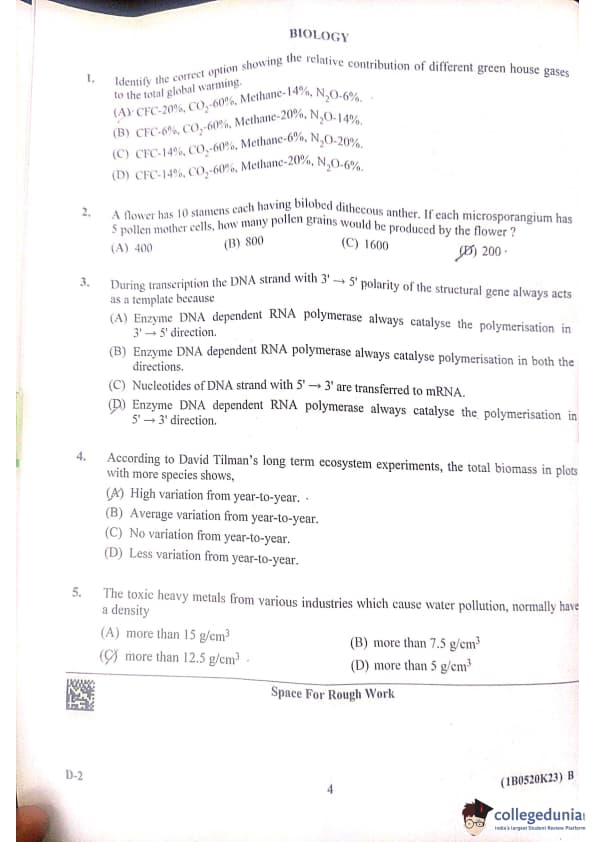
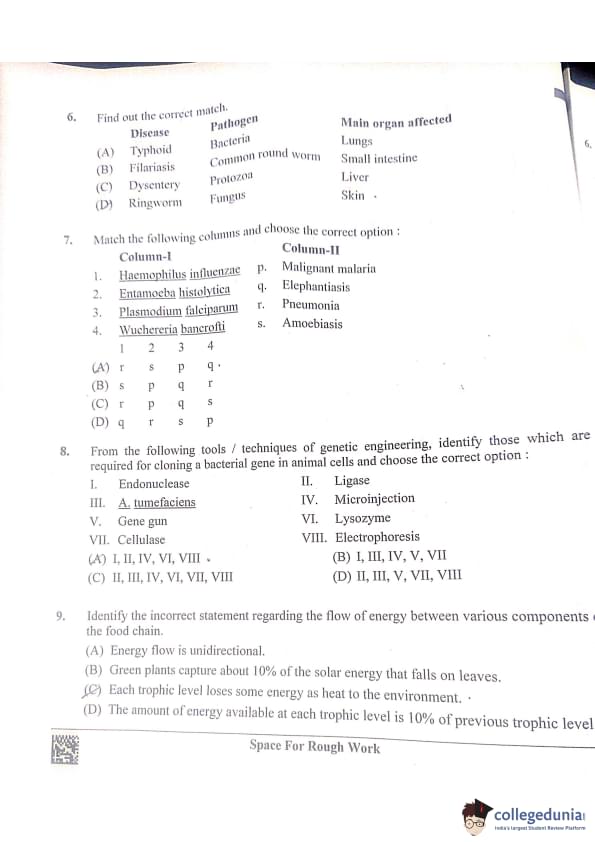
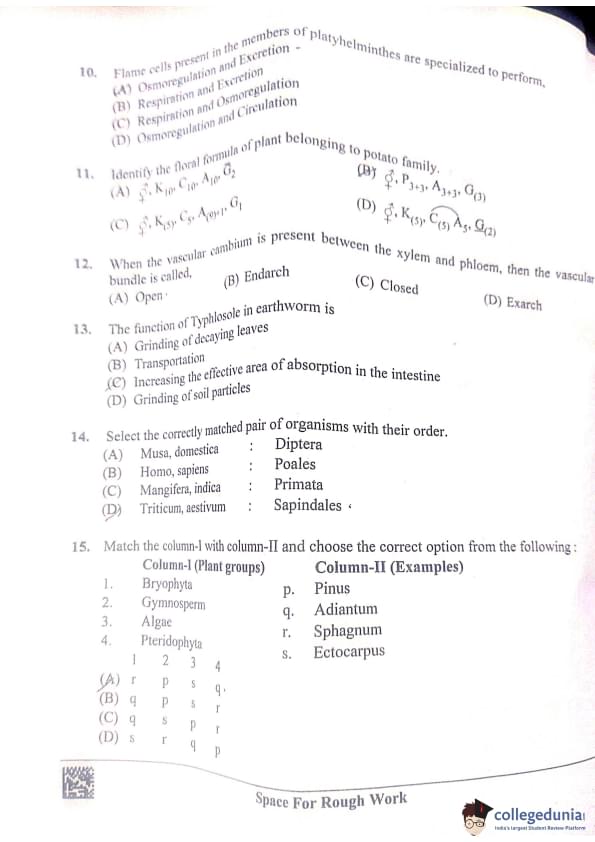
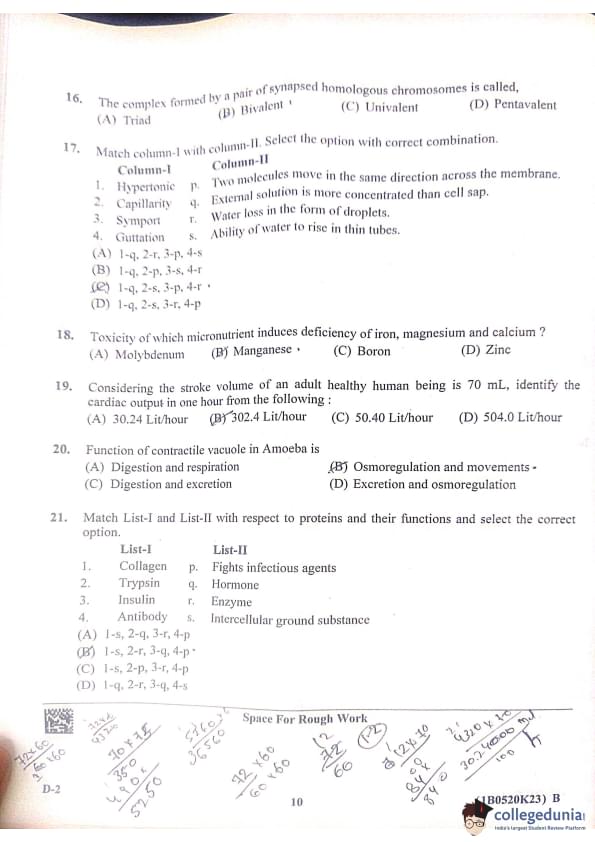
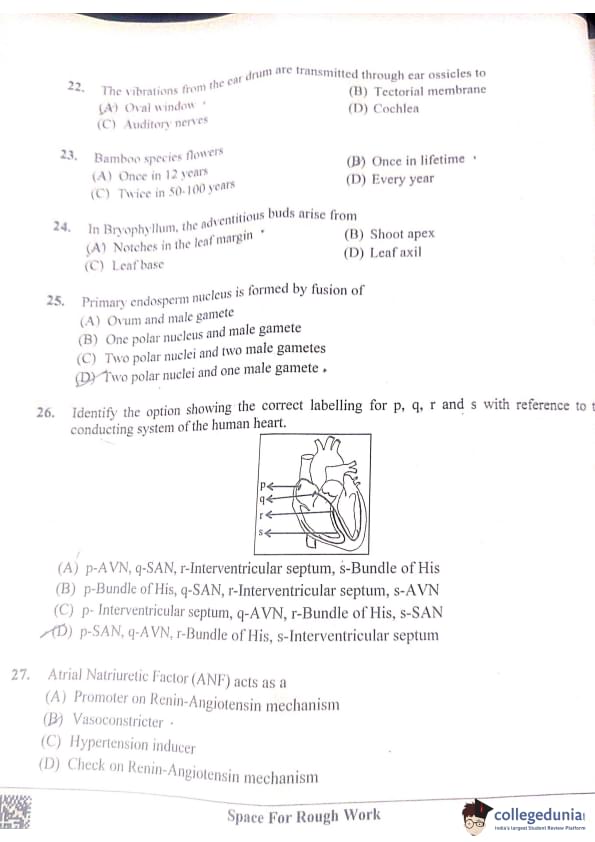
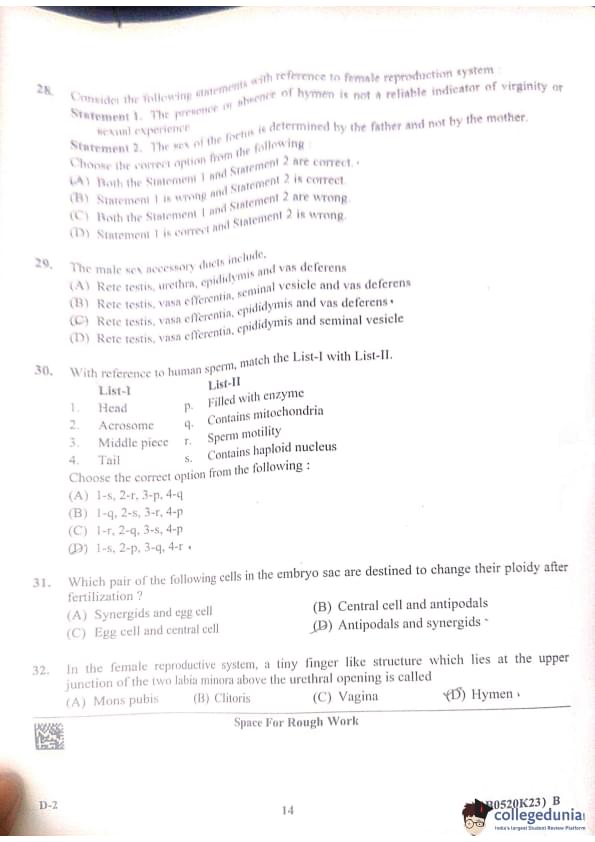
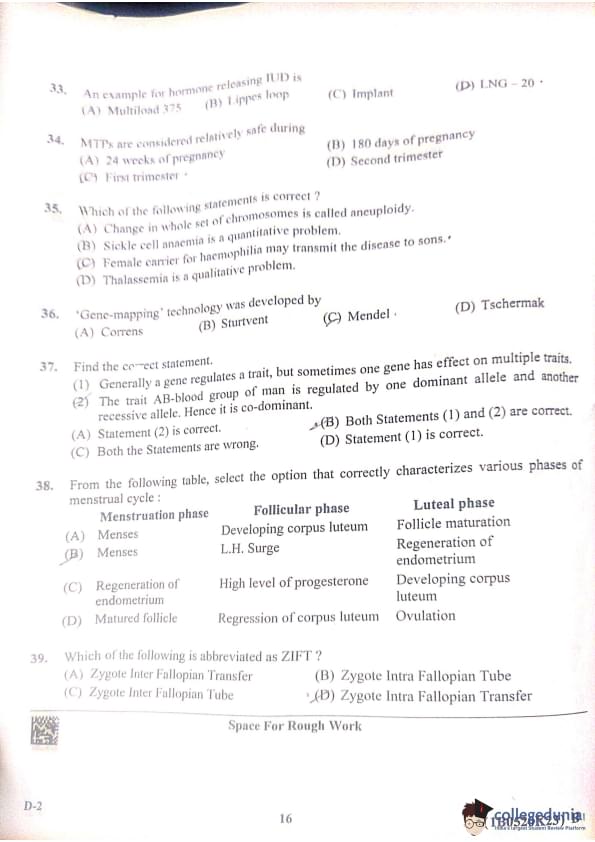
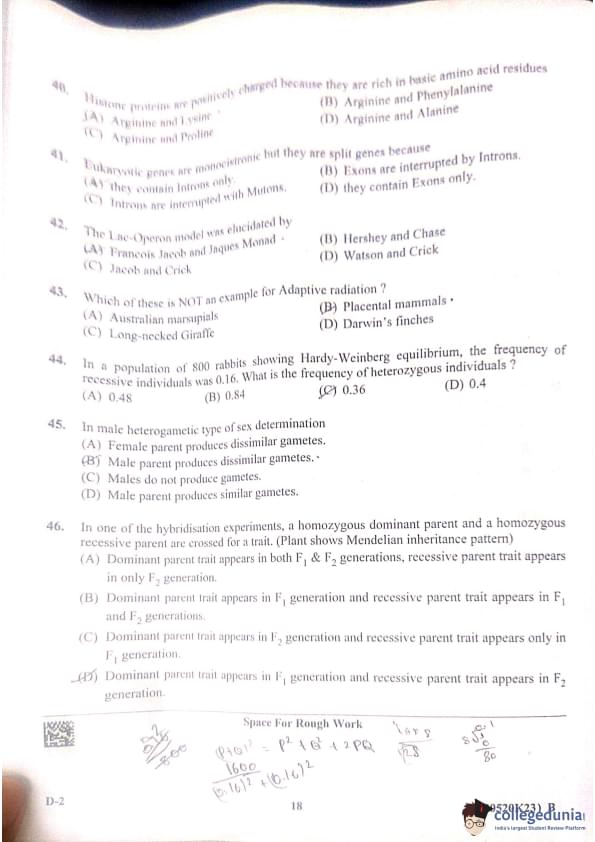
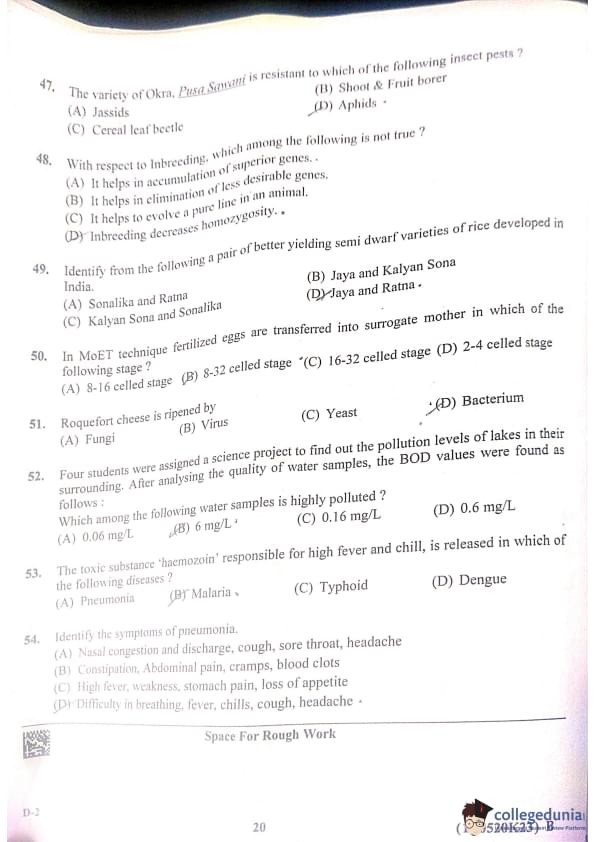
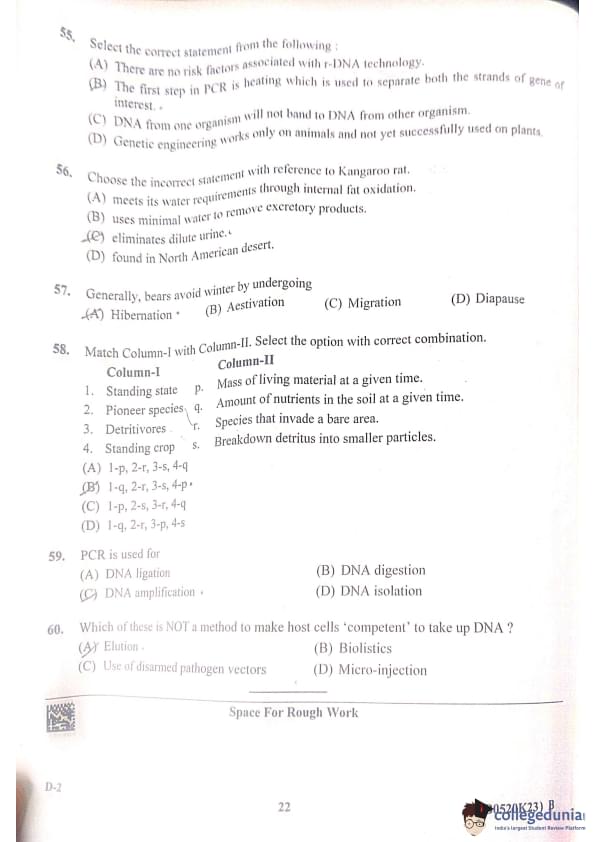
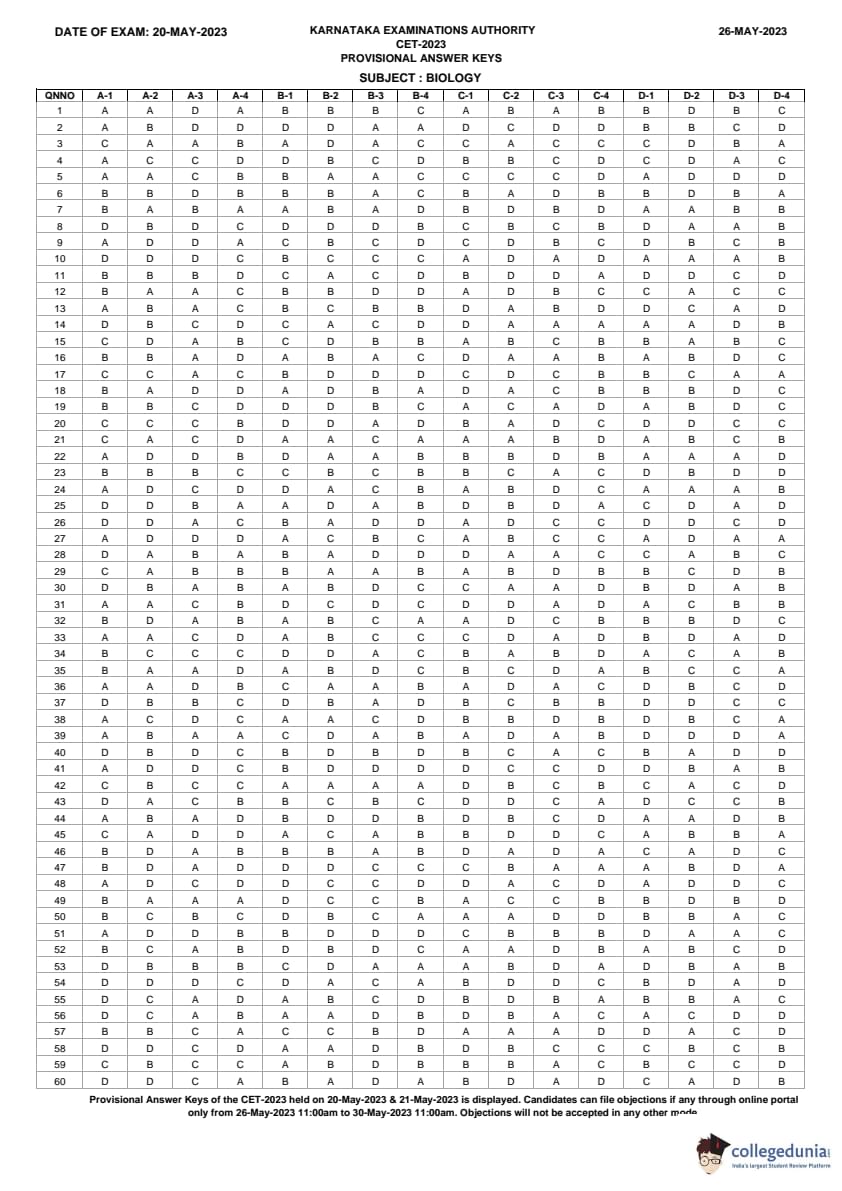




Comments